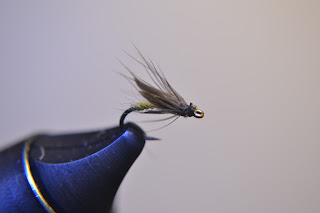Nailing wings to patterns that sink is nothing new, you just rarely see it anymore. I love to fish drown spinner flies with a tungsten bead head which is nothing more than a modern age wet fly. I have always believed one of the reasons they "get ate" is the profile, flash and movement a set of spent wings bring to the subsurface game. It's funny how we put so much emphasis on dry fly wings and fish can't see them but we often leave details like wings off our subsurface bugs where fish get a 360 degree view.
Ever notice how good that Adams dry fly works when its drowned?
The best way to get noticed and maybe on the jumbo-tron after all is to stand out in the crowd and Retro is all the rage now a days. Make room for some tradition in your lockers lads, tie some wet flies.
Some insects spend time under water with a visible wing. whether it's prior to it's emergence, crippled or drown, egg laying or spent and most fishermen that tie don't bother to bang a wing on subsurface patterns.
Egg Laying BWO?
Diving Caddis?
Crippled PMD? next to some Red Quill Emergers?
Google wet flies and check out the whats, wheres and whys on some really cool patterns and then throw tradition to the wind if you want. Equip your favorite soft hackle or nymph with wings of Poly, Swiss Straw, No Fray, Web Wing, CDC, Mallard Flank, Hackle tips, Burnt wings or the very traditional married Duck Wing technique.
Burnt Hen Hackle and Partridge
CDC on a subsurface fly is basically doing what married duck did for our foretyers. Some of these modern materials are better suited to whipping up a wet fly quickly but I still think Duck looks the best and learning the "old" ways was fun.
This junk usually sits and patiently waits for warmer days. It's fun to find stuff like this months later and relive the eternal hope that goes with winter tying.
Snow piled up on your boat too?
Tie some flies, day dream.
Carry On







No comments:
Post a Comment